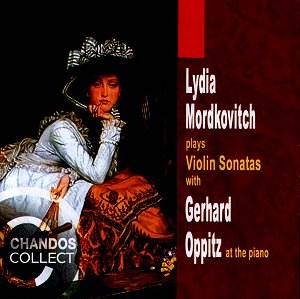This is a bargain priced box set of Lydia Mordkovitch's
violin sonata recordings made for Chandos in the 1980s. I am admirer
of her playing, particularly in the English repertoire, Howells, Dyson
and Vaughan Williams (the Carlton disc with Julian Milford is a lost
classic), none of which is unfortunately represented here. What we are
given is a cross-section of continental work with the emphasis heavily
on the Central-European tradition, tempered to some extent by the inclusion
of Prokofiev and Fauré. This make-up of the compilation, which
is a good showcase for the artist, makes sense, especially as Prokofiev
is given a separate disc to himself and the Fauré is the early,
romantic incarnation of that composer. Schubert, Schumann, Brahms and
Richard Strauss all have some sort of relation to each other, although
some more so than others. My preference here is for the Brahms sonatas,
the most advanced musically, obviously by their later dates (cf. Schubert
and Schumann) but also in that Nos. 2 and 3 belong to the late flowering
of Brahms' genius, the 100/108 opus numbers putting them close to, if
slightly before, the clarinet masterworks (quintet, sonatas etc.). The
Richard Strauss is, by contrast, a fairly early piece, predating the
mid-period bombast (Alpine Symphony, Zarathustra etc.),
but still rather florid in comparison to the late "neo-classical" masterpieces
like Metamorphosen and the Oboe concerto which are this
writer's preference among his works.
The earlier Brahms piece (No.1), written around the
same time as the celebrated Violin Concerto, is characterised
by two faster outer movements, framing a central Adagio based
on his Rain Song (Regenlied). The second, again a three movement
piece, had its genesis in the natural world of the lakeside at Thun
(Switzerland), reflected in its idyllic music, reminding me at times
of Hermann Hesse's book Klingsor's Last Summer, which has a similar
setting. The third sonata, more complex, looks forward at the same time
as revisiting some of Brahms' past triumphs, highlighted, respectively
by the mysterious third movement and virtuosic finale.
Both Prokofiev works follow the alternating "slow-fast-slow-fast"
four movement structure, the second (D major) being a rescored version
of the flute sonata which, incidentally, was also turned into a "concerto"
by the late Christopher Palmer. As you might expect, Mordkovitch does
full justice to her fellow Russian's inspirations, and to this listener
they represent, by far (maybe the Brahms excepted), the most outstanding
music on this set. The booklet quotes from the great David Oistrakh
comparing the first movement of the F minor, which he premiered,
to "the wind in a graveyard", indicating the depth and profundity of
utterance at work here. Perhaps it would have been even more useful
to include the composer's other violin sonata, the Op. 115 for
unaccompanied violin(s); there was an interesting recording of the latter
for "massed" violins, coupled with the aforementioned flute "concerto"
on Conifer which you may still be able to find.
I have never been much of an aficionado of either Schubert
or Schumann though, of course, there is no denying the brilliance of
the former, in particular. Their works included here occupy almost one
and a half hours so a potential purchaser does need to take this into
account. It is interesting that the coupling of Schubert items features
two works published posthumously but written years apart and occupying
almost different worlds entirely. The early Sonata features three
movements of relatively fast music, the Scherzo preceding the
gentle Andantino, whereas the extended one movement structure
of the Fantasie, is linked in Jeremy Siepmann's brief but authoritative
notes, to the Wanderer Fantasy and an earlier song (Sei mir
gegrüsst).
Schumann's first and second sonatas were written within
three months in the latter half of 1851 and are relatively late works.
The second is almost twice the length of the first and has an additional
fourth movement. In both works there are periods of "agitation" but
the slow movements, placed second and third respectively, are calmer
and more lyrical, that of the second sonata being based on a chorale
much beloved of J.S. Bach.
I cannot concur with the booklet notes that Richard
Strauss's E flat major sonata is a masterwork but, despite numerous
allusions and quotations to/from other composers (Chopin, Schubert,
Beethoven and Wagner for starters), it does have considerable charm,
coupled with a foretaste, in places, of the future originality and excess
of the composer's middle period works.
The recital ends with Fauré, again a nice enough
piece but hardly comparable with late masterpieces like the second Piano
Quintet and the String Quartet. The fact that the only composer
the booklet mentions in comparison is Schumann rather than Debussy or
Ravel should indicate fairly clearly where this work was coming from.
On the whole this is a mixed bag; I cannot fault the
performances but at least some of the works do not show their composers
in their best or most original lights and I couldn't really recommend
it as a package if it were offered at full price. However, it is not,
and as such it is well worth buying, mainly for the Prokofiev and Brahms
but also as a wider overview of the violin sonata from the mid-19th
century to the mid-20th.
Neil Horner

